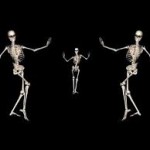
Ruthy Alon, one of Dr. Feldenkrais’s first students, said this about strength training:
“When you talk about strength, you think about muscles; I think about alignment of bones. When you arrange the bones, the muscles will know exactly the measure they need to invest….”
Walking the dogs today, I thought of what Ruthy said. Muscles get blamed a lot. When there’s pain, I often hear: it’s my periformis, or my QL, or my psoas. When a dog pulls the leash and I get yanked, it would be easy to focus on my shoulder and think I am not strong enough.
But this approach is wrong-headed and almost certainly futile. There are somewhere between 640 and 850 muscles in the human body and their structures are complex. The connections between muscles and the ways multiple muscles are recruited adds to the complexity.
The skeleton, on the other hand, is simple in outline and easy to grasp. The muscles are the servants of the bones. When you set up to lift a heavy weight you are, consciously or unconsciously, arranging your skeleton in a functional form. The better you are at arranging your skeleton the more you can lift without pain or injury.
Of course bones cannot move without muscles, but Dr. Feldenkrais used the bones as a starting point or cue for movement, rather than the muscles. Muscles, he said, are not smart. Your nervous is, however, brilliant and will recruit the right muscles at the right time, if given the right conditions.
Unfortunately, there is such a focus on muscles and strengthening muscles that we’ve ended up with gyms full of machines that require you to sit down while you “isolate” and exercise a muscle. Seated at the machine, your relationship with gravity doesn’t allow all of you to be involved in a functional way. You are back to the dog yanking the leash, thinking there’s something wrong with your shoulder or arm.
We need our muscles to be intelligent more than we need them to be stronger. Muscles can sometimes be flexible, sometimes loose, sometimes tight.
We need movement education that allows us to perform. That’s what Feldenkrais lessons are all about.
Speaking of performance, here’s one that will get you thinking skeletally. And make sense of the title of this post.

EXCELLENT piece, Anita. Especially love the video to show your point. Well done and thank you!